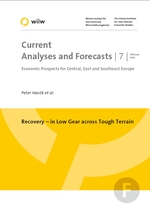Recovery - in Low Gear across Tough Terrain
Vasily Astrov, Vladimir Gligorov, Peter Havlik, Mario Holzner, Gabor Hunya, Sebastian Leitner, Zdenek Lukas, Anton Mihailov, Olga Pindyuk, Leon Podkaminer, Josef Pöschl, Sandor Richter and Hermine Vidovic
wiiw Current Analyses and Forecasts No. 7, March 2011
129 pages including 30 Tables and 23 Figures
You can also download separate country reports of this report
| No. | Title | Author | |
|---|---|---|---|
| 1 | Albania: Something is rotten | Mario Holzner | Free Download |
| 2 | Baltic States: Exports trigger broader based economic upswing | Sebastian Leitner | Free Download |
| 3 | Bosnia and Herzegovina: The choice between take-off and slow growth | Josef Pöschl | Free Download |
| 4 | Bulgaria: A painful rebalancing | Anton Mihailov | Free Download |
| 5 | Croatia: Difficult to come out of the crisis | Hermine Vidovic | Free Download |
| 6 | Hungary: Gradual recovery amidst persistent uncertainties | Sandor Richter | Free Download |
| 7 | Kazakhstan: Fast growth is back, but sustainability problems remain | Olga Pindyuk | Free Download |
| 8 | Macedonia: Stable recovery, rising political tensions | Vladimir Gligorov | Free Download |
| 9 | Montenegro: New government strives for stability | Vladimir Gligorov | Free Download |
| 10 | Poland: Continuing growth conditional on competent policy | Leon Podkaminer | Free Download |
| 11 | Romania: Election cycle ahead | Gabor Hunya | Free Download |
| 12 | Russian Federation: Oil-fuelled recovery stalls | Peter Havlik | Free Download |
| 13 | Serbia: Social tensions rise ahead of elections | Vladimir Gligorov | Free Download |
| 14 | Slovakia: Despite export-driven growth, high unemployment will persist | Zdenek Lukas | Free Download |
| 15 | Slovenia: Impact of the recession still strongly felt | Hermine Vidovic | Free Download |
| 16 | The Czech Republic: Growth slowdown after the 2010 speed-up | Leon Podkaminer | Free Download |
| 17 | Turkey: Calming-down of a growth bonanza | Josef Pöschl | Free Download |
| 18 | Ukraine: Advancing state's withdrawal from the economy | Vasily Astrov | Free Download |
The outlook for the world economy has improved in the course of 2010 and the recovery has gained strength in the EU as well. The Central, East and Southeast European countries (CESEE) have also recovered from the crisis; the majority of them recorded positive GDP growth. On average, the recent revival of exports has been even stronger than their growth before the crisis. By way of contrast, the trends in industrial output have so far remained more or less flat. The persistent decline in construction and fixed investments – both related to the still hesitant credit markets – represents one of the key downward internal risks to our moderately optimistic regional economic forecast.
The general outlook for the CESEE region in the baseline scenario reckons with a gradual strengthening of economic growth over the period 2011-2013, in most cases rarely exceeding 4% per annum. GDP growth will become more broadly based. The formerly predominant role of external demand will weaken somewhat, while both household consumption and gross fixed investments will ultimately contribute positively to GDP growth. With exports, industrial output levels and eventually also GDP growth having already recovered, the economy is seen as having largely returned ‘back to normal’ – yet with at least two important differences: (1) post-crisis growth will be slower. That slower growth, however, also implies that (2) the labour market situation will be ‘very far from normal’ as unemployment will remain high, with young and low-skilled workers being especially adversely affected, and any improvement only gradual and delayed.
Inflation rose throughout 2010 as food and commodity prices soared; in general, however, it will pose no (or little immediate) threat. The moderate economic upturn and a revival of capital inflows have resulted in renewed appreciation pressures. The forecasts point to a gradual deterioration of current account positions in all CESEE countries, yet the return (or persistence) of extreme imbal-ances are only expected for Montenegro, Albania and Serbia. The financing constraint with respect to both domestic and external loans will constitute one of the key brakes on future economic growth. Given the sorry state of public finances and the ensuing budget consolidation efforts, we cannot expect any new additional growth-stimulating measures from the public sector – on the contrary, owing to the limited fiscal space government deficits and public debts will be scaled back.
The sharp drop in GDP in most CESEE countries during the crisis resulted in both absolute and relative declines in their per capita GDP. The catching-up process of the previous decade was thus interrupted and income gaps vis-à-vis Western Europe widened. In the baseline GDP growth sce-nario wiiw reckons with a renewed catching-up process starting as early as 2011 (after losing 5 to 7 years in terms of income convergence).
Related Publications
Reference to wiiw databases: wiiw Annual Database, wiiw Monthly Database
Keywords: Central and East European new EU member states, Southeast Europe, future EU member states, Balkans, former Soviet Union, Turkey, economic forecasts, employment, foreign trade, competitiveness, exchange rates, inflation, monetary policy
JEL classification: G01, G18, O52, O57, P24, P27, P33, P52
Countries covered: Albania, Baltic States, Bosnia and Herzegovina, Bulgaria, Visegrad countries, CIS, Croatia, Czechia, Estonia, European Union, Hungary, Kazakhstan, Latvia, Lithuania, North Macedonia, Montenegro, New EU Member States, Poland, Romania, Russia, SEE, Serbia, Slovakia, Slovenia, Turkey, Ukraine
Research Areas: Macroeconomic Analysis and Policy, Labour, Migration and Income Distribution, International Trade, Competitiveness and FDI
